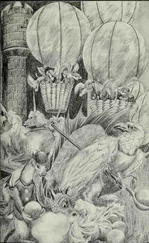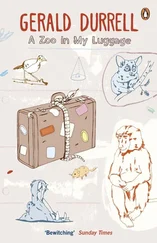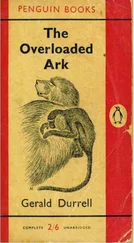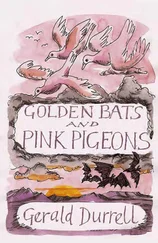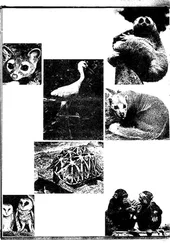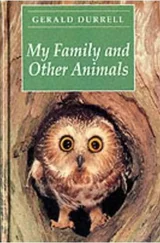I had once been fortunate enough to witness the hatching of some baby pipa toads, and I was anxious to see if we could breed them in the zoo. So I ordered a pair from a dealer, and on their arrival installed them in the reptile house. We kept them in a large aquarium full of water, for, unlike other toads, pipas are entirely aquatic. They settled down very well, and were soon devouring monstrous earthworms by the score. All we had to do now, I thought, was wait for them to breed. One morning Shep came to me and said that one of the pipas had apparently bruised itself on the stomach, though he could not see how this had happened. I examined the toad and discovered that what appeared to be a bruise was something which looked like a gigantic blood blister. It was difficult to know what to do. If the toads has not been aquatic and had had dry skin, I would have anointed the area with penicillin. Within twenty-four hours both pipas were dead, their bodies covered with the red blisters, which were full of blood and mucus. I sent them away for post-mortem, and the report came back that they were suffering from an obscure disease called ‘red-leg’. I had a strong feeling that this had something to do with the water in which they had been kept: it was ordinary tap water but rather acid. So I purchased another pair of pipas, and this time we kept them in pond water only. This has, so far, proved successful, and at the time of writing both toads are flourishing. With a bit of luck, I might get around to breeding pipa toads yet, unless they can think up something new to frustrate me.
Another amphibian with almost equally fascinating breeding habits as the pipa is the little pouched frog. We had five of these delightful, tubby little frogs, handsomely marked in green and black, which were brought to us from Ecuador. They did very well, eating prodigiously, but they showed no signs of wanting to breed. So we moved them into a bigger tank, where they had more land and water space, and this did the trick. Out of the breeding season, the female’s pouch, which is on her lower back, is scarcely noticeable. If you look closely you can see a faint line down the skin, with a slightly puckered edge, as if at one time the skin had been torn and healed up rather badly. However, when the breeding season comes round, the slit becomes much more obvious. The frogs begin to sing to each other, and presently you will see the females going off into quiet corners and indulging in a very curious action. They manage, by great contortion, to get one hind leg at a time up over their backs, insert the toes into their pouches and proceed to stretch the skin. When the pouch is stretched to their satisfaction, they are ready to breed. The method by which they put the eggs into the pouch is still a mystery to me, for unfortunately I missed the actual egg-laying. The next thing we knew was that the female had a bulging pouchful of spawn which protruded from her back and made her look as though she had been disembowelled. The female carries the eggs around until she knows, by some means or other, that the tadpoles are ready to hatch, whereupon she goes and sits in the water. The tadpoles wriggle free of the gelatine-like spawn and swim off on their own, the mother taking no further interest in them. We found that the tadpoles did very well on strips of raw meat and white worms—the tiny worms that fish fanciers breed as food. When they grew their legs and came out on land, we fed them on fruit flies and tiny earthworms, until they were old enough to graduate to house-flies and bluebottles.
Amphibians are much easier to breed than reptiles, for with them you do not have to worry about the moisture. Reptiles lay eggs with a parchment-like shell which is either soft or hard. If the temperature of the cage is not right, and if the moisture content of the air is too great or not enough, the contents of the egg will either dry up or become mildewed. Although we have had some successes with hatching reptile eggs, the chances against are always ninety to one. One success we did achieve, of which we were rather proud, was in hatching some Greek tortoise eggs. The Greek tortoise is probably one of the commonest pets, and it invariably lays eggs with monotonous regularity, but these very seldom hatch. Thinking that this batch of eggs was going to be just as successful as all the others had been, Shep did not worry over-much about them. He buried them in the sand at the bottom of one of the cages which had what he thought was a suitable temperature. Week after week passed, and eventually he forgot all about them. He was, therefore, considerably astonished one morning to find a baby tortoise perambulating about the cage. He called me and we dug up the rest of the eggs. Out of the six, four were in the process of hatching. In one egg the baby was almost out, but in the other three the babies had only just started to breach the shell.
We placed them in a small aquarium on a saucer of sand, in order to watch the hatching more conveniently. The eggs were almost the size of ping-pong balls, and much the same shape; the parchment-like shell was tough, and it was clearly an exhausting job for the babies to break out of their prisons. The one who had made the biggest hole in his shell could be seen quite plainly inside, as he twisted round and round, now using his front feet and now his back ones to enlarge the hole. On his nose he had the little horny ‘beak’ which baby tortoises are supposed to use to make the first breach in the shell; this later drops off. But I did not see this one use his ‘beak’ at all -the hard work was done with the front and hind legs, with frequent pauses for him to regain his strength. It took him three-quarters of an hour to break out, and then the egg split in half and he trundled off across the sand, wearing one half on top of his carapace, like a hat. When they emerged from the egg, their shells were spongy, misshapen, and extremely soft, and they were each the diameter of a two-shilling piece. However, after an hour or so a change had taken place; it was as though someone had inflated them with a bicycle pump. The shell had filled out, and instead of being flattened it was now handsomely domed and looked much harder, although it was, in actual fact, still as soft as damp cardboard. They were now so much larger than the egg that, unless I had watched them hatching myself, I would have said they could not possibly have emerged so recently from such a small prison. I noticed that their nails, when they hatched, were very long and sharp, presumably to help them break through the shell. Within a very short time, though, they had worn down to a normal length.
I had spent several hours watching this hatching process, and it was worth every minute. I had the greatest admiration for those rotund and earnest little tortoises, for breaking out of the egg was no easy matter. What amused me most, I think, was the way—after he had been using the hind feet to enlarge the hole—the tiny reptile would swivel round inside the shell, and the next moment a minute, wrinkled and rather sad little face would be poked through the hole in the shell, as if the tortoise wanted to reassure himself that the outside world was still there and still as attractive as it had been when he last looked. We were very lucky to have been able to hatch these tortoises, but what was even luckier was the fact that Ralph Thompson, who illustrated this book, happened to be staying with me at the time, and was thus able to draw the whole of the process from start to finish, which he assured me he thoroughly enjoyed, in spite of the fact that, owing to the high temperature in the reptile house, his glasses kept misting over.
4
CLAUDIUS AMONG THE CLOCHES
Dear Mr Durrell,
Do you ever stuff your animals? If you ever wanted to stuff your animals I could stuff them for you, as I have a great experience in stuffing animals…
Читать дальше

